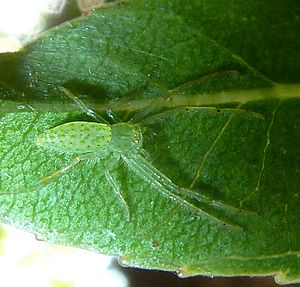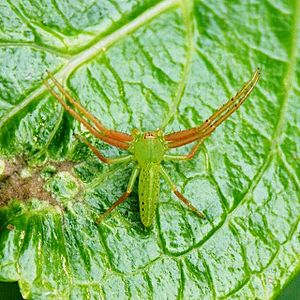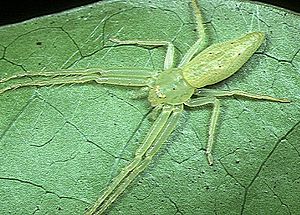Grass crab spiders facts for kids
Quick facts for kids Grass crab spiders |
|
|---|---|
 |
|
| A female green grass crab spider, O. argenteooculata, on a Cussonia leaf | |
| Scientific classification |
|
| Kingdom: | Animalia |
| Phylum: | Arthropoda |
| Subphylum: | Chelicerata |
| Class: | Arachnida |
| Order: | Araneae |
| Infraorder: | Araneomorphae |
| Family: | Thomisidae |
| Genus: | Oxytate L.Koch, 1878 |
| Type species | |
| Oxytate striatipes L.Koch, 1878
|
|
| Diversity | |
| 26 species | |
| Synonyms | |
|
|
Grass crab spiders are a group of fascinating spiders known for their unique hunting style. They are called Oxytate by scientists. These spiders are mostly active at night, making them nocturnal hunters. They belong to the family of crab spiders, which means they often walk sideways, just like crabs!
The first species of grass crab spider, O. striatipes, was identified in 1878 by a scientist named L. Koch. There are currently 26 known species in this group.
Hunting Habits
Like other crab spiders, Oxytate spiders are experts at ambushing their prey. They don't spin webs to catch food. Instead, they wait patiently for an unsuspecting insect to come close.
These spiders hunt at night. They often hide on a grass stem or underneath a leaf. They can feel tiny movements or vibrations caused by insects walking on the leaf above them. When they sense prey, they quickly pounce!
When waiting for prey on twigs or grass, they use their short back legs to hold on tight. Their long front legs are stretched forward, ready to grab their next meal. Don't worry, their bite is not harmful to humans.
Spider Anatomy

Even though grass crab spiders don't build webs, both male and female spiders have a special system for making silk. This silk is used for different purposes, like creating a safe place to lay eggs or for safety lines.
Scientists studied the O. striatipes species to learn about their silk-making parts. They found that these spiders have a simpler silk system compared to other spiders that wander around. Female Oxytate spiders do not have the special glands needed to make silk for cocoons (egg sacs) or for building large webs.
However, both male and female grass crab spiders have three main types of silk glands. These are called ampullate, pyriform, and aciniform glands. Each type of gland produces a different kind of silk.
The silk glands are connected to small tubes called spinnerets. These are located at the back of the spider's body and are used to release the silk. Different glands connect to different spinnerets to produce the various silk threads.
Where They Live
Grass crab spiders can be found in many parts of the world. They live in Asia, Western Australia, and in East, Central, and Southern Africa.
Known Species
There are many different species of Oxytate spiders. Here are some of them:
- Oxytate argenteooculata (Simon, 1886) — Central, East, Southern Africa
- Oxytate attenuata (Thorell, 1895) — Myanmar
- Oxytate bhutanica Ono, 2001 — Bhutan, China
- Oxytate capitulata Tang & Li, 2009 — China
- Oxytate chlorion (Simon, 1906) — India
- Oxytate clavulata Tang, Yin & Peng, 2008 — China
- Oxytate concolor (Caporiacco, 1947) — Ethiopia
- Oxytate elongata (Tikader, 1980) — India
- Oxytate forcipata Zhang & Yin, 1998 — China
- Oxytate greenae (Tikader, 1980) — Andaman Islands
- Oxytate guangxiensis He & Hu, 1999 — China
- Oxytate hoshizuna Ono, 1978 — China, Japan
- Oxytate isolata (Hogg, 1914) — Western Australia
- Oxytate jannonei (Caporiacco, 1940) — Ethiopia
- Oxytate kanishkai (Gajbe, 2008) — India
- Oxytate leruthi (Lessert, 1943) — West, Central Africa
- Oxytate multa Tang & Li, 2010 — China
- Oxytate parallela (Simon, 1880) — China, Korea
- Oxytate phaenopomatiformis (Strand, 1907) — Zanzibar
- Oxytate placentiformis Wang, Chen & Zhang, 2012 — China
- Oxytate ribes (Jezequel, 1964) — Ivory Coast
- Oxytate sangangensis Tang et al., 1999 — China
- Oxytate striatipes L. Koch, 1878 — Russia, China, Korea, Taiwan, Japan
- Oxytate subvirens (Strand, 1907) — Sri Lanka
- Oxytate taprobane Benjamin, 2001 — Sri Lanka
- Oxytate virens (Thorell, 1891) — Vietnam, Singapore


